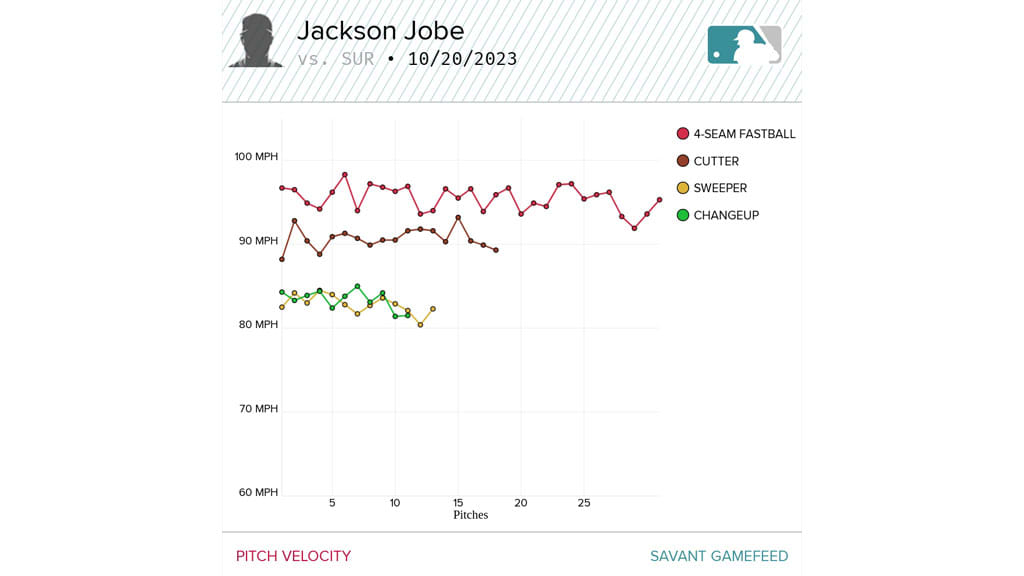No pitching prospect has as much current helium as Jackson Jobe.
The Tigers right-hander began 2023 on the injured list with lumbar spine inflammation and returned to the mound in the Rookie-level Florida Complex League on June 17. From there, he not only showed health but utter dominance, finishing with a 2.81 ERA, a 0.98 WHIP, 84 strikeouts and six walks in 64 innings across four levels including a late spot start for Double-A Erie. Jobe made up for the lost time in the Arizona Fall League and continued to produce (2.87 ERA, 19 strikeouts in 15 2/3 innings) before his time in the desert was completed this past weekend.
The 2021 third overall pick has long been known for spin rates above 3,000 rpm on his slider, but his fastball, changeup and newfound cutter all show signs of being plus pitches as well. Ranked as MLB Pipeline's No. 54 overall prospect for now before a certain jump in the next update, Jobe chatted with us about the pitch grips, ideal metrics and general usage for his four-pitch arsenal.
FASTBALL
Using a four-seam grip, Jobe splits the middle of the ball with his middle finger, places the pointer to the side, and then in his words, “half-tucks” his right thumb on the bottom seam in an attempt to create as much backspin as possible.
That last detail is important. Jobe has long shown velocity. He was around 92-94 mph in high school and was up to 94-97 in the Fall League, topping out at 98.3 – a mark he hit twice (once in his first AFL start and once in his last). But velo isn’t the only thing to consider on a heater, and that’s been an adjustment during the righty’s early time in pro ball.
“I definitely had a dead-zone fastball in high school, being that it was quote-unquote flat,” Jobe said. “I didn’t have much ride or any ride or anything. I didn’t do a good job of utilizing the spin efficiency and getting to stay behind it.”
Tigers pitching coaches and coordinators identified the issue about halfway through his 2022 season (when he had a 4.52 ERA in 18 starts at Single-A Lakeland) and got to work on potential fixes, including keeping Jobe’s wrist as stiff as possible in his throwing motion to increase the efficiency of the spin.
“In a perfect world, I like it to be 18-plus [inches of induced vertical break],” Jobe said. “Horizontal, I don’t really pay attention to. Just trying to get as much perceived ride as I can and get [swings-and-misses] at the top and takes at the bottom.”

SLIDER
The 21-year-old thought his slider was special as a teenager but didn’t quite know how unique it was until he got his hands on harder data.
“I think the first time TrackMan or something was put on me, I was 16, and I was spinning it at 3,200 rpm,” he said. “Everyone loved it, and I had no idea what it meant. I think that might just be a God-given thing right there. I didn’t really work on it or anything. I just had it, I guess.”
Jobe made three of his four AFL starts in front of Statcast cameras at Salt River Fields. His 34 sliders in that span averaged 2,952 rpm and topped out at 3,183. Noting the small sample, that would place fifth for highest average spin rate among MLB sliders (with a minimum of 100 pitches) in 2023 and seventh among sweepers.
Notably, Jobe calls it a slider, but he understands why some go the other way.
“I say my slider, on average, gets anywhere from 10 to 17 inches of horizontal, so it is kind of like a sweeper,” Jobe said. “As far as depth goes, I think I get a little more depth than a traditional sweeper. I try to throw it a little harder than some of the sweepers out there. I think it's a little different, but you could definitely categorize it with the sweepers.”
The velo on the slider was in the 82-85 mph range in the Fall League, and like his fastball, Jobe does pay attention to vertical movement on the breaking pitch too. After doing away with a curveball from his prep days, the hurler wants to keep his slider from bleeding back into that pitch.
“The vert I try to keep 0 to -1,” he said. “When you start getting -5 or more, it gets to be more of a curveball. And then obviously, if I’m getting to positive vert, it’s where I’m getting under it. I try to stay out of the positives, but not get too deep into the negatives.”
CUTTER
With the curveball pocketed, Tigers officials approached their No. 3 prospect toward the end of 2022 about adding a cutter instead. The natural supination in his throwing motion that aids his slider also came in handy in picking up the cutter during the offseason, and Jobe implemented the pitch upon his midsummer return to the Minors.
Using an offset four-seam grip, the Detroit prospect puts the most pressure on his middle finger and tries to “rip it as hard as I can like a fastball.”
“With that one, I’m trying to get a little bit of horizontal movement, but I want to be able to throw it in the low 90s,” Jobe said. “So we’re looking at like -3 to 5 inches of horizontal is where I’d like it to be at. Obviously, I have the slider that’s bigger, so this one’s a lot easier to control, especially behind in the count.”
Jobe’s cutter sat 88-92 mph in the Fall League, topping out at 93.2 on Oct. 20. Twenty-seven of his 35 AFL cutters (as measured by Statcast) came when he was behind or even in the count.

CHANGEUP
As new as the cutter is, Jobe has been most enthused by the development of his changeup in 2023. He adjusted a split-like grip – though he still calls it a changeup – to place his pointer along the seam of the ball.
“Most guys you talk to, I feel, try to pronate off of their middle finger, whereas I try to pronate off my index finger,” Jobe said. “So I try to get the seam and really pronate through it. Then the split kills some of the spin, which is going to give us some more depth.”
It’s the style of grip – first picked up back home in Oklahoma with pitching coach Alex Marney – that’s taken some time for Jobe to get comfortable with, but the more he’s thrown it, the more that has happened.
Jobe threw 25 changeups in front of Statcast this fall, ranging typically from 83-86 mph with an average spin rate of 1,636 rpm, and got called strikes or whiffs on 11 of them for a CSW rate of 44 percent, well above the “good” standard of 30. Because of the improved change, he held AFL left-handed batters to a .185/.241/.185 line over 29 plate appearances, but even same-sided batters have to watch out.
“I definitely think it makes it tough on a righty having to protect a slider running away, a fastball up and then a changeup in,” Jobe said.
